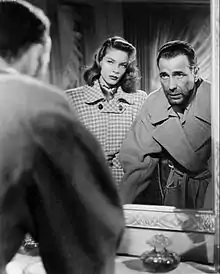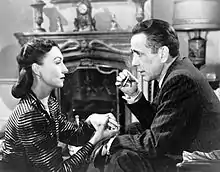Dark Passage (film)
Dark Passage is a 1947 American mystery thriller film directed by Delmer Daves and starring Humphrey Bogart and Lauren Bacall.[3][4] The film is based on the 1946 novel of the same title by David Goodis. It was the third of four films real-life couple Bacall and Bogart made together.[5]
| Dark Passage | |
|---|---|
_poster.jpg.webp) Theatrical release poster | |
| Directed by | Delmer Daves |
| Produced by | Jerry Wald |
| Screenplay by | Delmer Daves |
| Based on | Dark Passage by David Goodis |
| Starring | |
| Music by | Franz Waxman |
| Cinematography | Sidney Hickox |
| Edited by | David Weisbart |
Production company | |
| Distributed by | Warner Bros. |
Release date |
|
Running time | 106 minutes |
| Country | United States |
| Language | English |
| Budget | $1.6 million[1] |
| Box office | $3.4 million[1][2] |
For its initial scenes, the film was shot subjectively from the male lead's point of view to avoid showing the face of Vincent Parry (Bogart), prior to the point in the story at which he undergoes plastic surgery to change his appearance. In those scenes shot from other perspectives, the camera is positioned so that the field of view does not include his face. The story follows Vincent's attempt to hide from the law and clear his name of murder.[4]
Plot

Vincent Parry, convicted of killing his wife, escapes from San Quentin Prison and evades police by hitching a ride with a motorist named Baker. A radio news report about an escaped convict and Parry's odd clothes make Baker suspicious, so when questioned, Parry beats him unconscious. Irene Jansen picks him up and smuggles him past a police roadblock into San Francisco, offering him shelter in her apartment.
Madge, Jansen's acquaintance, comes by Irene's apartment, but Parry (through a closed door) tells her to leave. A former romantic interest whom Parry had spurned, Madge testified at his trial out of spite, providing a motive as to why he would have killed his wife. Irene explains that she had followed Parry's case with interest and that she believes Parry is innocent. Her own father had been falsely convicted of murder, and since then she has taken an interest in miscarriages of justice.
Parry leaves but is recognized by a cab driver, who turns out to be sympathetic and gives Parry the name of a plastic surgeon who can change his appearance. Parry arranges to stay with a friend, George Fellsinger, during the recuperation from the surgery and asks George for help in proving his innocence.
Following the operation, Parry is unable to speak with his face wrapped in bandages. He returns to George's apartment and finding him murdered, returns to Irene's apartment where he collapses at her doorstep. Irene nurses him back to health.
Madge and her ex-fiancé Bob, who is romantically interested in Irene, come by. Madge asks to stay with Irene for protection, worried that Parry will kill her for testifying against him. Irene gets rid of Madge and deflects Bob by saying that she has already met someone to whom she is attracted, "Vincent Parry".
She feigns that she is lying, but actually she is telling the truth, as Parry hides in a bedroom. Bob takes Irene's statement as a joke, but accepts that Irene is interested in another man. Parry recuperates and learns that he is wanted for George's murder, his fingerprints having been found on the murder weapon, George's trumpet. After his bandages are removed, Parry reluctantly parts from Irene, declaring that she will be better off if she is not part of his life.
Parry decides to flee the city before trying to discover who really killed his wife. At a diner, an undercover policeman becomes suspicious because of Parry's behavior. The policeman asks for identification, but Parry claims to have left it at his hotel. On the street, Parry darts in front of a moving car to escape. At the hotel, Parry is surprised by Baker, who holds him at gunpoint. Baker has been following Parry since they first met. He now demands that Irene pay him $60,000 or he will turn Parry over to the law. Parry agrees, and Baker obliges him to drive the two of them to Irene's apartment. Claiming to take a shortcut, Parry drives to a secluded spot underneath the Golden Gate Bridge, where he succeeds in disarming Baker and questions him, becoming convinced that Madge is behind the deaths of his wife and friend. The two men fight, and Baker falls to his death.
Parry goes to Madge's apartment. Knowing she does not recognize him with his new face, he pretends to be a friend of Bob's and feigns interest in courting her. Parry eventually reveals his true identity and accuses Madge of having killed both his wife and George. He shows her that he has all the evidence written down, and attempts to coerce her into making a confession. She points out that without her signature the accusations will then be worthless. While turning away from him, she accidentally falls through a window to her death.
Knowing he cannot prove his innocence, and that he will likely be accused of Madge's murder as well, Parry has no choice but to flee. He intends to go to Mexico and then to South America. He phones Irene, revealing his plans; she says she will meet him there. The next time we see him, Parry is relaxing with a drink in a beach bar in Peru, when he sees Irene across the dance floor. They embrace.
Cast

- Humphrey Bogart as Vincent Parry
- Lauren Bacall as Irene Jansen
- Bruce Bennett as Bob
- Agnes Moorehead as Madge Rapf
- Tom D'Andrea as Cabby (Sam)
- Clifton Young as Baker
- Douglas Kennedy as Detective Kennedy in Diner
- Rory Mallinson as George Fellsinger
- Houseley Stevenson as Dr. Walter Coley
- John Arledge as Lonely Man (uncredited)
- Frank Wilcox as Vincent Parry (picture in the newspaper, uncredited)
Production
Warner Bros. paid author David Goodis $25,000 for the rights to the story, which had originally been serialized in The Saturday Evening Post from July 20 to September 7, 1946, before being published in book form.[6] At the time that Dark Passage was shot, Bogart was the best-paid actor in Hollywood, averaging $450,000 a year.[7]
Robert Montgomery had made the film Lady in the Lake (1946) which also uses a "subjective camera" technique, in which the viewer sees the action through the protagonist's eyes. This technique was used in 1927 in France by Abel Gance for Napoléon[8] and by the director Rouben Mamoulian for the first five minutes of Dr. Jekyll and Mr. Hyde (1931). Film critic Hal Erikson believes Dark Passage does a better job at using this point-of-view technique, writing, "The first hour or so of Dark Passage does the same thing—and the results are far more successful than anything seen in Montgomery's film."[9]
According to Bacall, in her autobiography By Myself, during the filming of Dark Passage, Bogart's hair began to fall out in clumps, the result of alopecia areata, although photos from their 1945 wedding show Bogart to be losing his hair two years earlier. By the end of filming he wore a full wig. Bogart eventually had B12 shots and other treatments to counteract the effects, but he was helped by the fact that in his next film, The Treasure of the Sierra Madre he was required to wear a full wig.[7]
Filming locations
Parts of the film were filmed on location in San Francisco, California, including the Filbert Steps and the cable car system. The elegant Streamline Moderne Malloch Building on Telegraph Hill was used for the apartment of Irene Jansen where Parry hides out and recuperates from his surgery.[10][11][12] Apartment Number 10 was Jansen's. The current residents of that apartment occasionally place a cutout of Bogart in the window.[13] The diner was "Harry's Wagon" at 1921 Post Street, a long-closed diner in the Fillmore District of San Francisco.
Critical reception
Film critic Bosley Crowther gave the film a mixed review and was not impressed by Bogart's performance but was impressed by Bacall's work. He wrote,
When [Bogart] finally does come before the camera, he seems uncommonly chastened and reserved, a state in which Mr. Bogart does not appear at his theatrical best. However, the mood of his performance is compensated somewhat by that of Miss Bacall, who generates quite a lot of pressure as a sharp-eyed, knows-what-she-wants girl.
He made the case that the best part of the film is:
San Francisco ... is liberally and vividly employed as the realistic setting for the Warners' Dark Passage. Writer-Director Delmar Daves has very smartly and effectively used the picturesque streets of that city and its stunning panoramas ... to give a dramatic backdrop to his rather incredible yarn. So, even though bored by the story—which, because of its sag, you may be—you can usually enjoy the scenery, which is as good as a travelogue[14]
As of December 2018, the film has a 93% "Fresh" rating at Rotten Tomatoes, based on 27 reviews.[15]
Box office
The film earned $2,318,000 domestically and $1,112,000 in overseas markets.[1]
See also
References
- Warner Bros financial information in The William Shaefer Ledger. See Appendix 1, Historical Journal of Film, Radio and Television, (1995) 15:sup1, 1-31 p 28 DOI: 10.1080/01439689508604551
- "Top Grossers of 1947". Variety. 7 January 1948, p. 63.
- Variety film review; September 3, 1947, p. 16.
- Harrison's Reports film review; September 6, 1947, p. 142.
- The first two Bacall-Bogart films were To Have and Have Not (1944) and The Big Sleep (1946); the fourth would be Key Largo (1948). Dark Passage at IMDb.
- "Notes" on TCM.com
- Stafford, Jeff. "Dark Passage" on TCM.com
- Brownlow, Kevin (1983). Napoleon: Abel Gance's Classic Film (1st ed.). New York: Knopf. pp. 56–57. ISBN 0-394-53394-1.
- Erikson, Hal. Dark Passage at AllMovie.
- CitySleuth (November 7, 2010). "Dark Passage – Irene's Apartment". ReelSF.com. Retrieved July 22, 2013.
- Poletti, Therese (January 20, 2012). "Streamline Moderne gem a quiet star in "Dark Passage" at Noir City Film Festival". Retrieved July 22, 2013.
- King, John (June 14, 2009). "Malloch building: suave delight on storied hill". SFGate. Retrieved July 22, 2013.
- Boxer, Lou (October 29, 2010). "NoirCon and David Goodis revisit Dark Passage in San Francisco". NoirCon. Retrieved February 21, 2012.
- Bosley Crowther (September 6, 1947). "'Dark Passage,' Warner Thriller, in Which Humphrey Bogart and lauren Bacall Are Chief Attractions, Opens at Strand". The New York Times. p. 11. Retrieved December 21, 2007.
- Dark Passage at Rotten Tomatoes. Last accessed: December 30, 2018.
External links
| Wikimedia Commons has media related to Dark Passage (film). |
- Dark Passage at IMDb
- Dark Passage at the TCM Movie Database
- Dark Passage at AllMovie
- Dark Passage at the American Film Institute Catalog
- Dark Passage trailer at Spike TV
